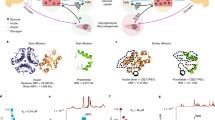Abstract
Objective:
Endogenous peptide YY3–36 (PYY3–36) is associated with postprandial regulation of appetite. We investigated the safety and effectiveness of peripherally administered synthetic human PYY3–36 for 14 days in New Zealand white rabbits. Weight gain and food consumption were assessed and pharmacokinetics and toxicity characterized.
Research methods and procedures:
In all, 24 animals were randomized to one of four intravenous treatment groups – control (0.9% saline) or PYY3–36 bolus at 4.1, 41.0, or 205 μg/kg/day. Body weight and consumption of fixed food allotment were measured daily. Hematology and serum chemistries were profiled at baseline and Day 15, and pharmacokinetics measured following dose 14. Histopathologic examination of designated tissues and organs in control and PYY3–36 205 μg/kg animals was conducted. All animals were subject to clinical and macroscopic observation.
Results:
The trend effect of higher dose PYY3–36 on lower average weight was significant (P=0.01; Day 14 compared to baseline) and its effect on reduced food consumption was suggested (P=0.065; number of days ⩽75% food eaten, compared with control). Hematology and clinical chemistries were within normal limits pretest and at Day 15. No clinical, macroscopic, histologic, or microscopic changes related to the test article were observed over the course of study.
Discussion:
Lower average weight occurs in rabbits treated once daily with intravenous injection PYY3–36 (205 μg/kg/day) over 14 days. No clinical or histologic signs of toxicity were observed. Further research is warranted to describe alternate routes of peripheral administration for optimizing weight control.
This is a preview of subscription content, access via your institution
Access options
Subscribe to this journal
Receive 12 print issues and online access
$259.00 per year
only $21.58 per issue
Buy this article
- Purchase on Springer Link
- Instant access to full article PDF
Prices may be subject to local taxes which are calculated during checkout


Similar content being viewed by others
References
Eberlein GA, Eysselein VE, Schaeffer M, Layer P, Grandt D, Goebell H et al. A new molecular form of PYY: structural characterization of human PYY(3–36) and PYY(1–36). Peptides 1989; 10: 797–803.
Keire DA, Mannon P, Kobayashi M, Walsh JH, Solomon TE, Reeve JR . Primary structures of PYY, [Pro34] PYY and PYY (3–36) confer different conformations and receptor selectivity. Am J Physiol Gastrointest Liver Physiol 2000; 279: G126–G131.
Pedersen-Bjergaard U, Hoest U, Kelbaek H, Schifter S, Rehfeld JH, Faber J et al. Influence of meal composition on postprandial peripheral plasma concentrations of vasoactive peptides in man. Scand J Clin Lab Invest 1996; 56: 497–503.
Adrian TE, Ferri GL, Bacarese-Hamilton AJ, Fuessl HS, Polak JM, Bloom SR . Human distribution and release of a putative new gut hormone, peptide YY. Gastroenterology 1985; 89: 1070–1077.
Cowley MA, Smart JL, Rubinstein M, Cerdan MG, Diano S, Horvath TL et al. Leptin activates the anorexigenic POMC neurons through a neural network in the arcuate nucleus. Nature 2001; 411: 480–484.
Batterham RL, Bloom SR . The gut hormone peptide YY regulates appetite. Ann NY Acad Sci 2003; 944: 162–168.
Grandt D, Schimiczek M, Beglinger Ch, Layer P, Goebell H, Eysselein VE et al. Two molecular forms of peptide YY (PYY) are abundant in human blood: characterization of a radioimmunoassay recognizing PYY1–36 and PYY3–36 . Regul Peptides 1994; 51: 151–159.
Grandt D, Teyssen S, Schimiczek M, Reeve JR, Feth F, Rascher W et al. Novel generation of hormone receptor specificity by amino terminal processing of peptide YY. Biochem Biophys Res Comm 1992; 186: 1299–1306.
Schwartz MW, Woods SC, Porte Jr D, Seeley RJ, Baskin DG . Central nervous system control of food intake. Nature 2000; 404: 661–671.
Sheikh SP . Neuropeptide Y and peptide YY: major modulators of gastrointestinal blood flow and function. Am J Physiol 1991; 261: G701–G715.
Batterham RL, Cowley MA, Small CJ, Herzog H, Cohen M, Dakin C et al. Gut hormone PYY3–36 physiologically inhibits food intake. Nature 2002; 418: 650–654.
Batterham RL, Cohen MA, Ellis SM, Le Roux CW, Withers DJ, Frost GS et al. Inhibition of food intake in obese subjects by peptide YY 3–36. N Engl J Med 2003; 349: 941–948.
Institute of Laboratory Animal Research. Guide for the Care and Use of Laboratory Animals. Washington, DC: National Academy Press, 1996.
Cook RD . Detection of influential observations in linear regression. Technometrics 1997; 19: 15–18.
Draper NR, Smith N . Applied Regression Analysis, 3rd edn, Section 8.3. New York: John Wiley and Sons Inc., 1998.
Tekeli S . Occurrence of hair-fragment emboli in the pulmonary vascular system of rats. Vet Pathol 1974; 11: 482–485.
Halatchev IG, Ellacott KLJ, Fan W, Cone RD . PYY3–36 inhibits food intake through a melanocortin-4 receptor-independent mechanism. Endocrinology 2004; 145: 2585–2590.
Author information
Authors and Affiliations
Corresponding author
Rights and permissions
About this article
Cite this article
Sileno, A., Brandt, G., Spann, B. et al. Lower mean weight after 14 days intravenous administration peptide YY3–36 (PYY3–36) in rabbits. Int J Obes 30, 68–72 (2006). https://doi.org/10.1038/sj.ijo.0803067
Received:
Revised:
Accepted:
Published:
Issue Date:
DOI: https://doi.org/10.1038/sj.ijo.0803067
Keywords
This article is cited by
-
Role of gastrointestinal hormones in feeding behavior and obesity treatment
Journal of Gastroenterology (2016)
-
Type 2 Diabetes Control in a Nonobese Rat Model Using Sleeve Gastrectomy with Duodenal–Jejunal Bypass (SGDJB)
Obesity Surgery (2012)
-
Gastrointestinal satiety signals
International Journal of Obesity (2008)
-
The role of oxyntomodulin and peptide tyrosine–tyrosine (PYY) in appetite control
Nature Clinical Practice Endocrinology & Metabolism (2006)



